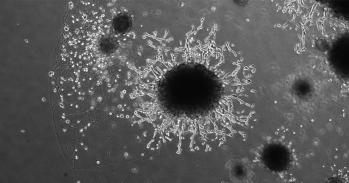
Nerve cells damaged in diseases such as multiple sclerosis (MS), ‘talk’ to stem cells in the same way that they communicate with other nerve cells, calling out for ‘first aid’, according to new research from the University of Cambridge.
Nerve cells damaged in diseases such as multiple sclerosis (MS), ‘talk’ to stem cells in the same way that they communicate with other nerve cells, calling out for ‘first aid’, according to new research from the University of Cambridge.
This is the first time that we’ve been able to show that damaged nerve fibres communicate with stem cells using synaptic connections – the same connections they use to ‘talk to’ other nerve cells
Thora Karadottir
The study, published today in the journal Nature Communications, may have significant implications for the development of future medicines for disorders that affect myelin sheath, the insulation that protects and insulates our nerve cells.
For our brain and central nervous system to work, electrical signals must travel quickly along nerve fibres. This is achieved by insulating the nerve fibres with a fatty substance called myelin. In diseases such as MS, the myelin sheath around nerve fibres is lost or damaged, causing physical and mental disability.
Stem cells – the body’s master cells, which can develop into almost any type of cell – can act as ‘first aid kits’, repairing damage to the body. In our nervous system, these stem cells are capable of producing new myelin, which, in the case of MS, for example, can help recover lost function. However, myelin repair often fails, leading to sustained disability. To understand why repair fails in disease, and to design novel ways of promoting myelin repair, researchers at the Wellcome Trust-Medical Research Council Stem Cell Institute at the University of Cambridge studied how this repair process works.
When nerve fibres lose myelin, they stay active but conduct signals at much lower speed than healthy fibres. Using electrical recording techniques, a team of researchers led by Dr Thora Karadottir discovered that the damaged nerve fibres then form connections with stem cells. These connections are the same as those that connect synapses between different nerve fibres. These new synaptic connections enable the damaged fibres to communicate directly with the stem cells by releasing the glutamate, a chemical that the stem cells can sense via receptors. This communication is critical for directing the stem cells to produce new myelin – when the researchers inhibited either the nerve fibres’ activity, their ability to communicate, or the stem cells’ ability to sense the communication, the repair process fails.
“This is the first time that we’ve been able to show that damaged nerve fibres communicate with stem cells using synaptic connections – the same connections they use to ‘talk to’ other nerve cells,” says Dr Karadottir. “Armed with this new knowledge, we can start looking into ways to enhance this communication to promote myelin repair in disease.”
Dr Helene Gautier from the Department of Physiology, Development and Neuroscience, adds: "So far, the majority of the available treatments are only slowing down damage. Our research opens the possibility to enhance repair and potentially treat the most devastating forms of MS and demyelinated diseases."
Reference
Gautier, HOB et al. Neuronal activity regulates remyelination via glutamate signalling to oligodendrocyte progenitors. Nature Communications; 6 Oct 2015

The text in this work is licensed under a Creative Commons Attribution 4.0 International License. For image use please see separate credits above.




